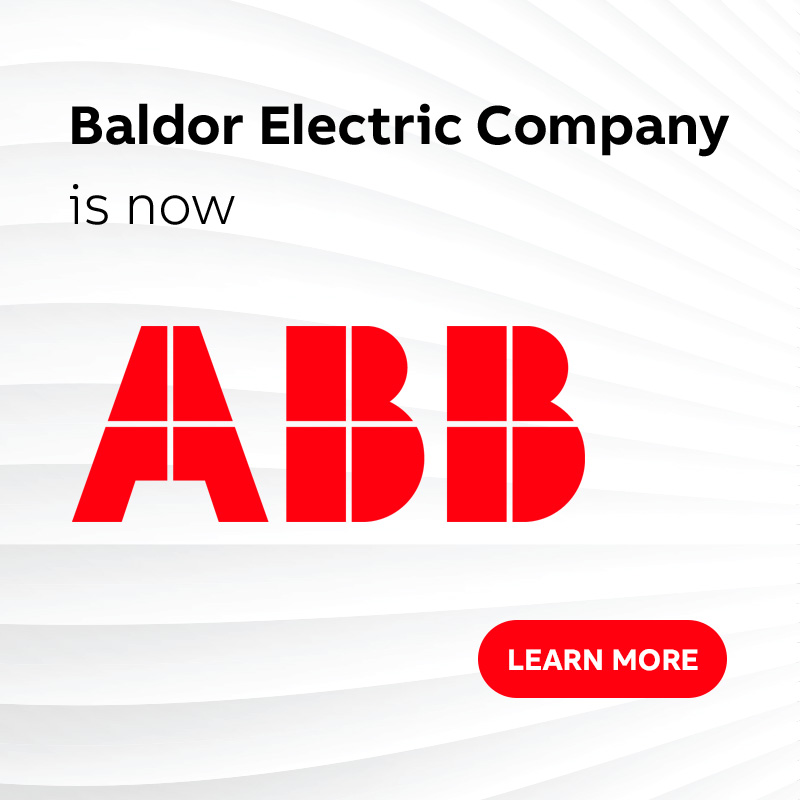
Harsh Conditions: Extreme Cold Weather Can Affect Your Large AC Motors
Written by: Todd Huston, Baldor Electric Company, Industry Account Manager
Large AC motors represent a substantial investment. Making the right selection and proper maintenance are critical to ensure reliability and long-term performance. There are many factors that go into specifying a large AC motor (generally larger than 500 HP at 1800 RPM), but the most important include understanding the application, knowing the environmental conditions, and determining the protection scheme.
The focus of this article will be on the environmental factors and maintenance procedures that impact motor design and reliability. Environmental conditions, specifically ambient temperature and altitude, have an effect on overall motor design. Large AC motors are designed for operation up to an ambient of 40oC and an altitude of 1000 metres. For every 100-metre increase in altitude, the motor must be de-rated by 1%. Therefore, at an altitude of 2000 metres, the motor would need to be de-rated by 10%.

When ambient temperatures fall below -25oC, additional consideration must be given to the types of materials used in manufacturing. The most common material changes will be in fans, shafts, frames and end brackets. Fans may need to be changed from plastic to either steel or bronze. Shaft material will likely be changed from a standard material, such as AISI 1040, to a high-strength alloy like AISI 4140. Cast-iron frames and end brackets will typically be changed from grey iron to ductile iron due to the brittle nature of grey iron in low-ambient conditions.
These material changes will need to be made at various ambient ranges between -25oC and -60oC, depending upon the standard material and application. In addition to low ambient, the harsh environments of resource industries require other considerations. Conditions common to harsh environments include outdoor installations, corrosive or salt-laden atmospheres and exposure to abrasive materials. In these scenarios, consideration must be given to the proper motor enclosure and bearing protection.
Totally enclosed motors are best suited for these harsh conditions. As the name implies, this motor is enclosed to the point of preventing free exchange of air between the inside and outside of the machine. Totally Enclosed Fan Cooled (TEFC) is the most common and well-known type of enclosed motor. TEFC motors rely on a shaft-mounted fan to blow cooling air over the ribbed frame, as the heat radiates from the interior of the motor. However, this configuration has size limitations. As the horsepower increases, the ability for the motor to radiate the heat to the exterior of the frame becomes increasingly difficult.
When you go beyond the availability of the traditional TEFC enclosure, your main choices become Totally Enclosed Air-to-Air Cooled (TEAAC) and Totally Enclosed Water-to-Air Cooled (TEWAC). TEAAC is a motor that has an air-to-air heat exchanger mounted on the motor to provide cooling. The TEWAC motor is cooled through the use of a water-to-air heat exchanger. Like TEFC, TEAAC uses a shaft-driven external fan to force cooling air through the heat exchanger tubes. Internal fans circulate the heat created by the motor around the tubes of the heat exchanger, thus providing the cooling.
The water-to-air heat exchanger method in the TEWAC motor is more efficient. It also allows motor sizing to be similar to open machines. If a sufficient amount of clean cooling water is available, TEWAC is a good choice. Protecting motor bearings also is an area that needs careful consideration in harsh environments. Various degrees of protection are available from shaft slingers to multi-labyrinth, non-contacting bearing isolators. Consult the motor manufacturer to determine the appropriate level of bearing protection that aligns with the level of exposure to which the motor will be subjected.

When installing a motor, make certain the foundation is properly designed to provide a level, massive foundation that will not affect the dynamics of the motor and driven equipment. Again, follow the manufacturer’s recommendations for proper shimming and alignment.
A commitment to routine maintenance must be embraced. In addition to following the required lubrication schedule, motor parameters should be checked to avoid a negative trend. Suggested monitoring of motor parameters would include current, vibration and temperature of the bearings and windings. For critical-service applications, these parameters may need to be monitored on a continuous basis.
In conclusion, because of the investment made in large AC motors, it’s important to understand and fully communicate your needs to the motor supplier. Understanding the application and the environment, as well as having sound practices in place for storage, installation and maintenance — will ensure the motor provides long-term reliability.
Read original article on WajaxConnections.com.

